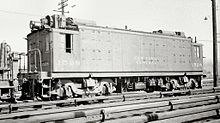Boxcab locomotive


A box cab locomotive , from English box “box” and cab “ driver's house ”, is a locomotive with a cuboid structure without any aerodynamic design of the vehicle ends. The term is particularly common in North America , where such locomotives were built in the 1910s and 1920s. Most boxcab locomotives were diesel or electric , but there were also some steam locomotives in boxcab design.
Diesel locomotives
The oldest box-cab locomotives with internal combustion engines were four gasoline-powered locomotives delivered to the Minneapolis, Northfield and Southern Railway from 1913 to 1915 . Most boxcab-design diesel locomotives were built before World War II . They were called Oil-Electric Locomotives "oil-electric locomotives" so that the unpopular German word diesel did not have to be used after the First World War .
The first larger series were the ALCO boxcab locomotives - small diesel locomotives for shunting services in the freight yards of New York City . They were built in series from 1925 after the Kaufman Act passed in 1923 banned the use of steam locomotives within the city limits from January 1926. The manufacturer was a consortium consisting of the American Locomotive Company (ALCo), General Electric (GE) and Ingersoll Rand (IR). GE was responsible for the electrics, ALCo for the mechanical part and IR for the diesel engine. The cooling systems were arranged on the roof and initially insufficient until forced ventilation with two electrically operated radial fans was introduced.
ALCo left the consortium in 1928 and, together with its own diesel engine manufacturer McIntosh & Seymour, developed locomotives of the HH series with end driver's cab and stems. General Electric and Ingersoll Rand continued to build the GE boxcab locomotives . Some locomotives were built for the New York Central Railroad as multi-power locomotives. The locomotives known as GE three-power boxcab locomotives could run on diesel engines, with electricity from the third rail , as well as with battery operation. The latter was used for maneuvering in factories where no exhaust emissions were permitted. The electrical operation was used for driving through the tunnels on the approach to New York. These locomotives were also used to deliver freight cars on the High Line .
Electric locomotives
Boxcab electric locomotives were used from the 1910s. They were used primarily on early electric railways in North America, such as the Pennsylvania Railroad , the electric operation through the Cascade Tunnel of the Great Northern Railway , Milwaukee Road , New York, New Haven and Hartford Railroad, and the Virginian Railway used. In Canada, electric boxcab locomotives were used on the routes through the Mont Royal and St. Clair tunnels .
In Europe, France in particular built boxcab locomotives. The execution was mostly carried out by Alstom , which had taken over the General Electric subsidiary Compagnie Francaise Thomson-Houston .
Web links
- S. Berliner, III: Boxcab Pages. Retrieved June 17, 2016 .
Individual evidence
- ^ Brian Solomon: American Diesel Locomotives . Voyageur Press, ISBN 978-1-61060-605-9 , pp. 34 ( Google Book [accessed June 14, 2016]).
- ^ Mark Garrett: Encyclopedia of Transportation: Social Science and Policy . SAGE Publications, 2014, ISBN 978-1-4833-4651-9 , pp. 469 ( Google Book [accessed June 14, 2016]).


